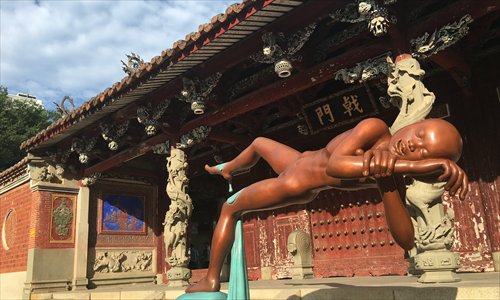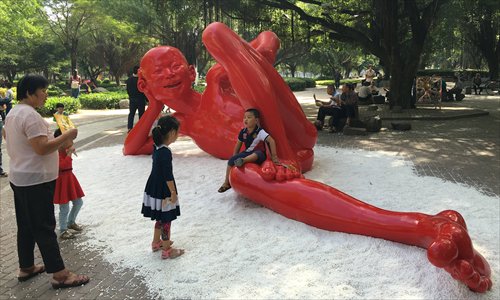HOME >> ARTS
Twisting tradition
By Li Jingjing in Quanzhou Source:Global Times Published: 2015-11-18 21:08:02
Contemporary exhibit brings art to rural China

Sping, a sculpture by Chen Wenling, is on display at the entrance to the Confucian Temple in Anxi county, Fujian Province, on November 8. Photo: Li Jingjing/GT

A child sits on a sculpture by Chen Wenling in a park near the Confucian Temple. Photo: Li Jingjing/GT
Built during the Northern Song Dynasty (960-1127),the Confucian Temple in Anxi county, Fujian Province, is one of the most well-preserved ancient buildings in China. Although its red-colored walls are a bit faded and some areas look a bit shabby, considering its age, it is a very interesting site, even more so now that several contemporary art works have been put on display in its courtyards.A metallic sculpture of a cow stands in front of one of the temple's halls, its modern elements standing in total contrast with the ancient Chinese building behind it.
This stark contrast is exactly the concept the exhibition The Vivid Spirit - Chinese Contemporary Art Invitational Exhibition in Anxi County, Quanzhou, Fujian Province is trying to convey.
"Since China's reform and opening up, the material lives of Chinese have undergone enormous changes, with China becoming a materialistic country. We have already done a pretty good job improving common courtesy, but there is more work to be done when it comes to people's spiritual needs. Society needs to rebuild a new cultural ecology," artist Chen Wenling, also the executive curator of the exhibition, said during an interview with the Global Times on November 8.
That's why he brought this contemporary exhibition to a small county in East China.
Anxi, a county of Quanzhou city, is famous for its Oolong tea and being the birthplace of Tieguanyin tea.
It was among the earliest coastal counties to open up during the 1980s and a large number of Taiwanese can trace their family roots to here.
Preserving most of Southern China's traditional culture, as well as its role as a key port between the Chinese mainland and the rest of the world, Quanzhou, combines tradition with a modern sense of opening up, according Wang Mingxian, the general curator of the exhibition.
"We were thinking about whether there were any new chances to create cultural clashes, and we discovered many artists are interested in this," Wang told media on November 8.
Wang said sometimes artists are actually less interested in exhibiting in Beijing or Shanghai. However, when they heard about the chance to exhibit their works at a Confucian Temple in Anxi county they showed strong interest, because its like "talking to Confucius... talking to tradition."
The exhibition gathered 50 artworks, including sculptures, installation works and paintings from about 25 artists such as Fang Lijun, Li Zhanyang and Xu Weixin as part of the 14th Asian Art Festival that was held in Fujian Province last week.
Approachable culture
The 46-year-old Chen was actually born in Quanzhou.
Although he is serving as a curator, many of his sculptures are also taking part in the exhibition, something that Chen is extremely happy about since it has been decades since he last held an exhibition in his hometown.
One of his sculptures features an ox, a turtle, a panda, the Statue of Liberty and an abacus all connected together to form a bridge.
"These things have come together to form a bridge that supports the entire human race. It consists elements from the East and West, and ancient and contemporary times. Everybody can find something that interests them."
Near the temple is a public park where local senior citizens and children tend to play and pass the time. The park has also taken part in the exhibition, displaying several huge sculptures by Chen.
Portraying red colored statues of laughing people lying or sitting down, these sculptures are some of Chen's most iconic works. Walking around the park, children could be seen sitting on or playing hide-and-seek around the sculptures.
"One thing that I feel really excited about is an installation work in a boat, a farmer on a motorcycle drove by looking at it with a smile on his face. I love this feeling. I think an artist or a work of art shouldn't pick and choose its audience," Chen said.
He explained that he wants his art to be close to those who love highbrow stuff, as well as people like rural villagers.
"That's a problem with some contemporary artists, they are not considerate and particularly odd sometimes. I believe that if you show the good side of human nature, your art will be understandable and people will be willing to approach you," Chen said.
The power of culture
"People in Beijing are already numb to art and therefore can't process it. But look at what a good appetite people here have. No matter how big of a cultural event comes here, they are able to process it," Chen said, explaining why, in his opinion, places like Anxi so easily accept contemporary art.
This is not the first time that contemporary art has tried blending in with small cities or villages.
It has actually become a trend in art circles in recent years. From bringing Andy Warhol's popart Chairman Mao to a small rural village to exhibitions such as the one at the Confucian Temple, smaller rural areas of China are getting a chance to see art that is normally reserved for the big cities.
"Our philosophy is to change villages through art," said Wang.
"There are a few benefits to holding exhibitions at local villages. First, villages do not have access to contemporary art, so these exhibitions are something new to them. Something may not prove popular in Beijing, but it can be a huge success in places like Anxi county. Second, I believe villages have reached a new level. Villages in China used to be very poor, and so had no access to art. But Anxi has risen to count among the riches counties in China," he said.
Posted in: Art